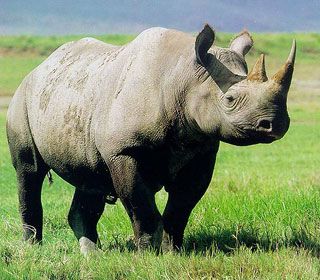Mammals: Black Rhinoceros

Description
The Black Rhinoceros (Diceros bicornis) is a mammal of the Perissodactyla order which lives in the eastern areas of Africa including Kenya, Tanzania, Cameroon, South Africa, Namibia and Zimbabwe. The black rhinoceros is on the endangered species list due to excessive poaching for their horns, which are mostly used in dagger handles as a symbol of wealth in many countries. Contrary to popular opinion, only small amounts of the horns are consumed as an aphrodisiac.
An adult black rhinoceros stands 5 feet (1.5 m) high at the shoulder and is anywhere from 10 to 12 feet (3 to 3.65 m) in length. An adult weighs from 1,000 to 3,000 lb (454 to 1362 kg), with the female being smaller. Two horns on the skull are made of keratin with the larger front horn as high as 28 inches (71 cm). Occasionally, a third smaller horn may develop. Skin color depends more on local soil conditions and their wallowing behaviour than anything else, so many black rhinos are typically not truly black in color.
The adults are solitary in nature but come together for mating, with the females accompanying their young during the rearing period. Sometimes, mothers and daughters may form small groups.
Population
The population of black rhinos have been severely reduced in the latter half of the 20th century. In the late 1960s, an estimated 70,000 strong lived in Africa. By 1991, only 10,000 to 15,000 remained in the wild and by 1993 only 2,475 black rhinos were reported to exist. Saving the black rhinos started in ernst at Hluhluwe-Umfolozi Game Reserve in South Africa. According to the IUCN/SSC African Rhino Specialist Group (http://www.rhinos-irf.org/), the population had recovered slightly to 2,599 by 1999. As few as five individuals of the West African subspecies may remain.



1 Comments:
Really? Well, that's good news! :)
By Daldianus, at 11:07
Daldianus, at 11:07
Post a Comment
<< Home